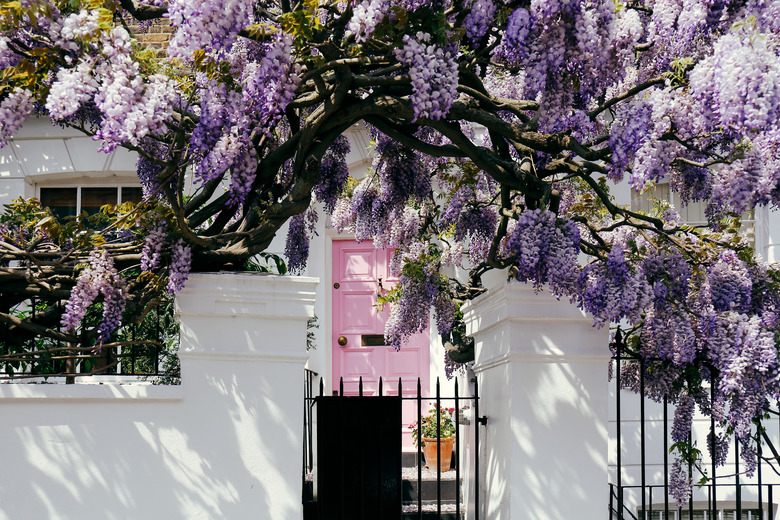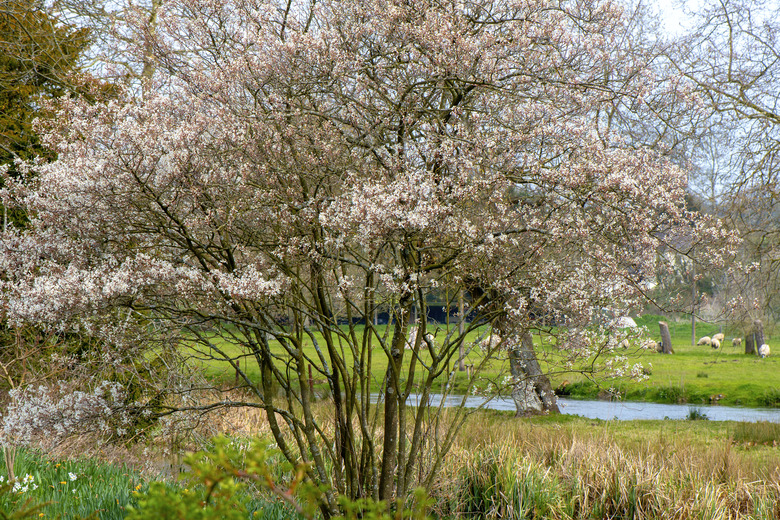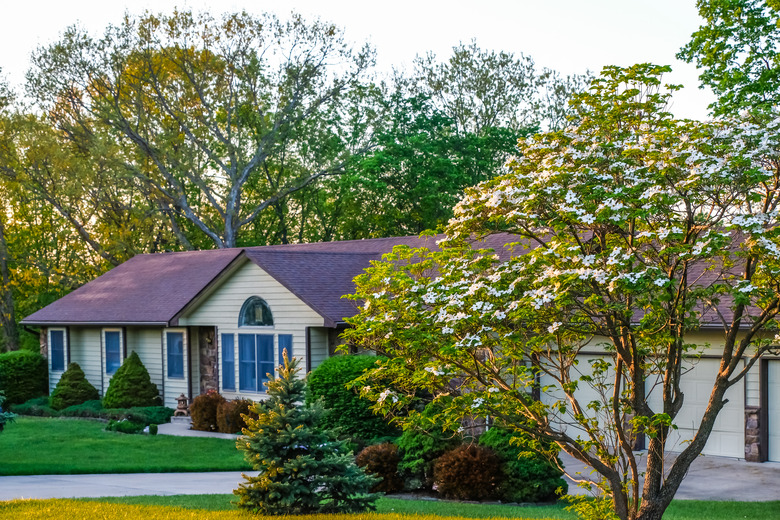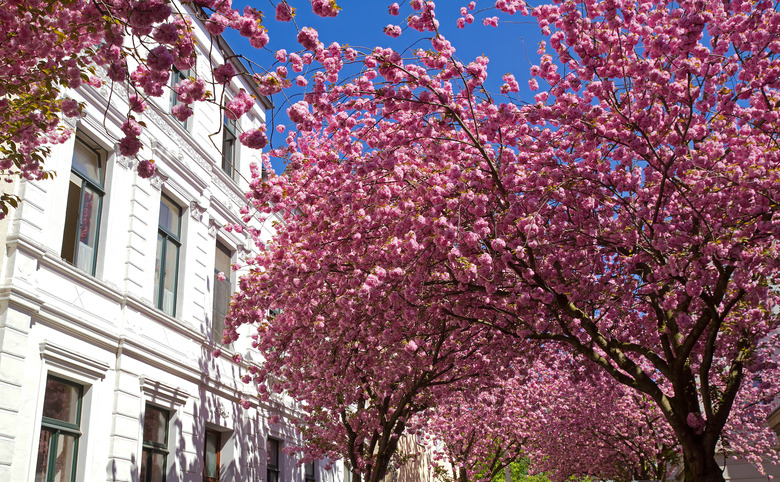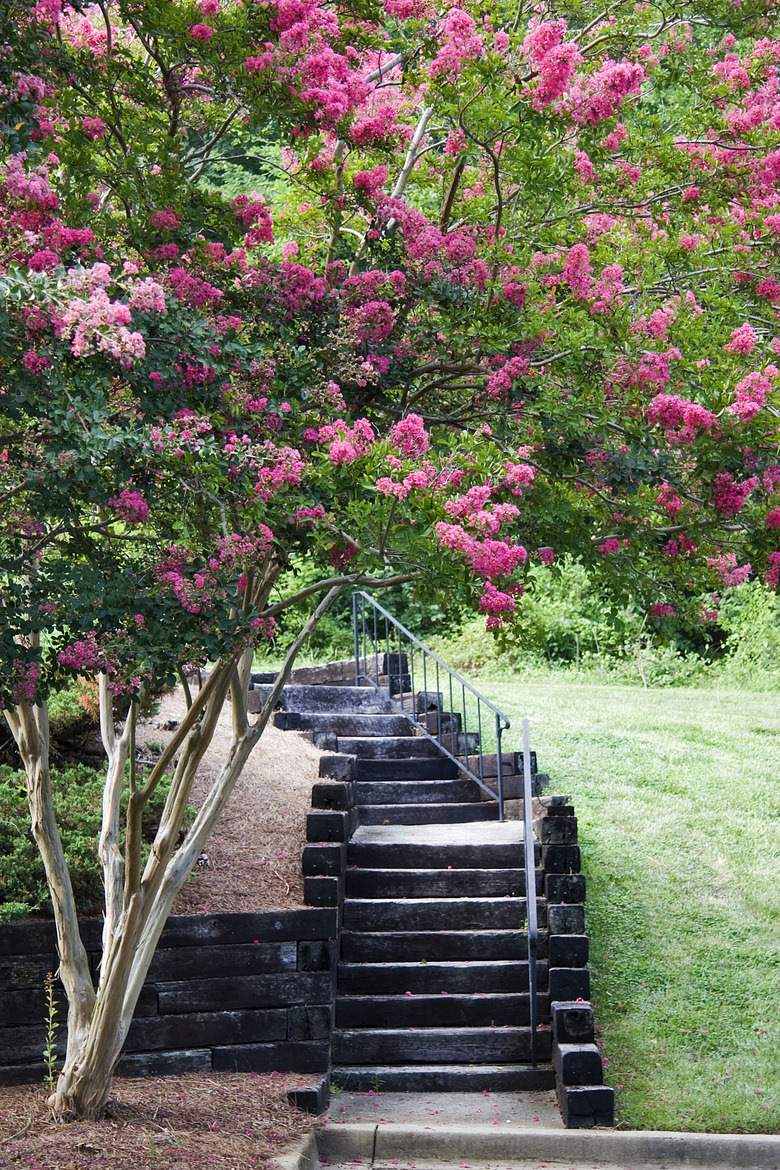10 Best Flowering Trees For Landscaping
We may receive a commission on purchases made from links.
Just like a bouquet of flowers can cheer up your dining room, flowering trees can light up your landscape. Since landscapes vary in size and circumstance, you'll find a vast range of trees with blossoms available from garden stores and nurseries, each with its own flowers and features. Consider some popular options for your own landscape.
Flowering Trees in Your Landscape
Flowering Trees in Your Landscape
Trees make a real statement in a backyard or garden, and they can play many roles. When you include flowering trees in your landscape, you automatically add a pop of sensory appeal. Blossoms on branches please the eye, add texture and color to a yard and can also bring fragrance depending on the tree you select.
Don't be in a hurry when it comes to choosing the trees to add to your yard. Many trees live decades, and some live hundreds of years, so it's important to select one that meets your needs. Your site has to meet the tree's needs as well, so be sure a flowering tree thrives in your climate and in the sun exposure available. Size is another matter that needs your attention since you want the planting location to accommodate the tree's fully mature size. Think through whether you want the tree to double as a shade tree or wind block before making a final decision.
1. Common Serviceberry Tree
1. Common Serviceberry Tree
Many types of edible berries grow on bushes, like blueberries, but serviceberries grow on trees. Common serviceberry trees (Amelanchier spp.) are native flowering trees that are graceful and airy, growing to 25 feet tall. They produce showy flowers in drooping clusters, each blossom with five white petals. The blooms arrive in early spring and don't last beyond a week, but the display takes your breath away.
The pome fruits arrive next, and the waxy blooms are followed by ripe berries in June. Wild birds love the berries, and they can be used to make delicious jams and jellies. The leaves of the serviceberry tree turn fiery shades in early fall: yellow, red and orange. The bark is also lovely; it is smooth and gray with vertical stripes.
Serviceberry trees thrive in U.S. Department of Agriculture plant hardiness zones 4 through 9. This species prefers a site with full sun and moist, well-drained, acidic soil.
2. Star Magnolia Tree
2. Star Magnolia Tree
The star magnolia (Magnolia stellata) is a popular flowering tree that is beloved for its early spring flowers. The flowers are different from the cup magnolias. Each star magnolia blossom has up to 18 slender petals. They are white tinged with pink and really stand out since they appear on the branches before the leaves, making for a spectacular show.
You might think a magnolia tree is too big for your small garden, but this is quite a small tree, maturing to about 20 feet tall and 15 feet wide. The trees are naturally multistemmed with a rounded tree form. They thrive in U.S. Department of Agriculture plant hardiness zones 4 through 9 and should be sited in a location that gets at least four hours of sun a day. The tree requires moist, well-draining soil. You might want to pick another tree if you live in an area with late spring frosts since the blossoms bloom very early.
3. Flowering Dogwood Tree
3. Flowering Dogwood Tree
According to the Missouri Botanical Garden, flowering dogwood trees (Cornus florida) might be the most beautiful native flowering trees in the country. It's a small tree, only growing to 30 feet tall and wide in a broad pyramid shape. The button-size flowers appear in early spring, tiny and yellowing green, but that's not the whole story. Each flower cluster is surrounded by four showy, white, petal-like bracts that look like a large, white blossom. In late summer or early fall, bright-red fruits appear, and in autumn, you'll see the dark-green leaves turn brilliant shades of red.
Flowering dogwood thrives in U.S. Department of Agriculture plant hardiness zones 5 through 9. This native tree is easy to grow in well-drained soils in full sun to partial shade. It prefers moist soil and will benefit from a layer of mulch to hold in water. It may be best to avoid this tree in Eastern states where dogwood anthracnose infestations are present.
4. Chinese Flame Tree
4. Chinese Flame Tree
If you are looking for a flowering tree with year-round interest, consider the golden rain tree, also called the Chinese flame tree (Koelreuteria bipinnata), hardy in U.S. Department of Agriculture plant hardiness zones 7 through 9. This deciduous tree produces long, drooping panicles of showy yellow blossoms in late summer, filling the garden with their sweet fragrance. The flowers yield to a profusion of rose-colored papery seed capsules in fall. The flame tree is deciduous, but the compound green leaves remain on the tree into early winter. They put on a fall display, turning canary yellow before falling.
Chinese flame trees are a good choice for small or medium-size landscapes. According to Cal Poly Urban Forest Ecosystems Institute, these trees can grow to 40 feet tall with a 30-foot spread, but they often remain smaller. The tree shape, spreading with a low canopy, makes it an excellent shade tree as well. Site this tree where it will get full or partial sun and be prepared to irrigate regularly.
5. Tuliptree or Tulip Popular Tree
5. Tuliptree or Tulip Popular Tree
The tuliptree (Liriodendron tulipifera) is also called the "tulip popular," even though it's not actually a poplar species. It's native to North America, which means that this flowering tree requires little maintenance in appropriate sites. This is a tall tree, topping out at 90 feet tall with a 50-foot spread, and would only be suitable for a large landscape. Tuliptrees grow best in U.S. Department of Agriculture plant hardiness zones 5 through 9. They require full sun, well-drained soil and regular irrigation, according to the Morton Arboretum.
Tuliptrees are part of the magnolia family, and their flowers have the same goblet shape as some magnolia blooms. The 2-inch blooms are distinctly showy, and the petals are yellow-green with an orange band at the base. The tulip-shaped flowers bloom in late spring and usually remain on the tree for several weeks. The "fruits" are cone-like seed clusters. An added ornamental feature is the tree's fall foliage, as the leaves turn deep yellow in autumn.
6. Japanese Flowering Cherry Tree
6. Japanese Flowering Cherry Tree
Japanese flowering cherry trees (Prunus 'Kanzan') are ornamental trees in the rose family. While many trees use this common name, the Kanzan cultivar is exceptional and one of the show stoppers of the Japanese cherry clan. It produces prolific amounts of double-pink blossoms in spring, offers red cherries in summer and the oval, green leaves make it an excellent shade tree. Those same leaves offer an autumn display when they turn orange-bronze before falling.
Kanzan Japanese flowering cherry trees thrive in U.S. Department of Agriculture plant hardiness zones 5 though 9. They can grow to a mature height of 36 feet tall if left on their own rootstock, but you can also find them with dwarf rootstock, keeping them well below 10 feet tall. Expect a vase-shaped tree form when the cherry tree is young, but the crown spreads more as the tree matures. Plant Kanzan trees in a full-sun or partial-sun location in well-drained loam soil.
7. Japanese Tree Lilac
7. Japanese Tree Lilac
Tree lilac, also called Japanese tree lilac, (Syringa reticulata) is a flowering ornamental that thrives in U.S. Department of Agriculture plant hardiness zones 3 through 7. Despite the common name "lilac," this tree bears pale ivory blossoms. They are frothy and showy, covering the canopy of the tree, and they have a strong fragrance.
The creamy-white flowers grow on long clusters called "panicles" that can be 12 inches long. These appear in early summer and are followed in late summer by the fruits, which are attractive dry capsules with decorative interest. Japanese lilac trees also have lovely bark — a soft brown, striated with lighter lines like on cherry trees.
The lilac tree itself has a graceful form, with most popular cultivars growing to 25 feet tall and 15 feet wide, according to the Morton Arboretum. These trees grow best in full sun and in moist, well-drained soil. The eye-catching flowers attract butterflies, bees and hummingbirds to your yard.
8. Washington Hawthorn Tree
8. Washington Hawthorn Tree
Washington hawthorn trees (Crataegus phaenopyrum) are deciduous trees that produce masses of snowy white flowers in early summer. The flowers remain on the tree for up to 10 days, according to Arbor Day Foundation. They are followed by bright-red berries. They grow in green and then slowly mature to brilliant red and hang on the branches into late winter, attracting songbirds.
Even the leaves are dramatic. Their shape is almost triangular, and they grow in reddish-purple, maturing to dark green in summer and then flaring orange, scarlet and purple in fall.
These American natives have a pleasing "fat pyramid" shape and can grow to between 25 and 35 feet tall and wide. Unlike many hawthorn species, Washington hawthorn is disease-resistant and has few pests, plus it is low maintenance. The trees thrive in U.S. Department of Agriculture plant hardiness zones 3 through 8 and prefer a sunny location (at least six hours a day) and well-drained soil.
9. Vossi Golden Chain Tree
9. Vossi Golden Chain Tree
For a spring-blooming tree with deep-yellow flowers, take a look at the golden chain tree (Laburnum x watereri 'Vossii'), which thrives in U.S. Department of Agriculture plant hardiness zones 6 through 8. It's a glorious, upright flowering tree offering long, drooping flower clusters of fragrant, bright-yellow blossoms from its spreading canopy. The blue-green foliage offers a stunning contrast.
You'll want to site this tree where it is sheltered from wind to protect those blossoms in late spring. It grows in full sun or partial shade and rich, well-drained soil. This tree is not drought-resistant and requires regular, deep watering sessions. You'll have to up the amount of irrigation when the weather gets hot.
The golden chain tree is a favorite in English country gardens, but given its small size, it also works well in small, urban gardens. You can also plant several together in a small grove.
10. Crape Myrtle Tree
10. Crape Myrtle Tree
For the best summer color, you might consider planting crape myrtle (Lagerstroemia indica). The common crape myrtle is a small tree, often multistemmed, that is loved for its stunning and showy flower display that starts in summer and continues right through fall. The attractive, dark-green foliage is a great contrast to the flower show and provides a vivid, fiery fall display. In winter, you can admire the exfoliating gray bark, peeling back to expose contrasting underbark.
These flowering trees are extremely popular in the South since they bloom brightly through the hottest weather from midsummer to autumn. These small trees grow to between 15 and 25 feet tall and thrive in U.S. Department of Agriculture plant hardiness zones 6 through 9. You can find cultivars with white, pink, lavender or red flowers. Plant them in full sun in well-drained soil.
References
- Arbor Day Foundation: Top 10 Flowering Trees
- UC Master Gardeners of Tulare & Kings Counties: Ornamental Tree Selection & Guide
- The Morton Arboretum: Tuliptree
- Cal Poly Urban Forest Ecosystems Institute: Chinese Flame Tree
- Missouri Botanical Garden: Cornus florida
- NC State Extension: Prunus 'Kanzan'
- The Morton Arboretum: Japanese Tree Lilac
- Arbor Day Foundation: Washington Hawthorn
- University of Wisconsin Master Gardener Program: Serviceberry, Amalanchier spp.
- Monrovia: Vossi Golden Chain Tree
- Arbor Day Foundation: Crapemyrtle (Crape Myrtle)
